Full Blood Exam, Full Blood Count, Blood Tests, Blood Investigations

Question 1. What is Full Blood Exam?
Blood is made up of 1) circulating cells and 2) Protein-rich fluid (plasma or serum). Blood cells are derived from bone marrow and lymph nodes. In circulation, cells are made up of red cell, platelets and white cells. Red cells contain haemoglobin giving its distinctive red colour and deliver oxygen from lungs and brings back waste product (carbon dioxide) away from tissue to be expelled via lungs. White cells are further sub-divided into neutrophils; monocyes; lymphocytes; basophils and eosinophils and each play various roles in controlling infections and inflammatory processes. Platelets help control bleeding and repair of damaged tissue.
Systemic diseases and blood disorders cause many changes to cellar components of blood. By measuring cellular components and examining their appearances in size, shape and staining characteristics in addition to counting the number of specific cells present in circulation, lead to a correct diagnosis can be made. The process of examining blood cells and haemoglobin content is called Full Blood Examination (FBE) or Full Blood Count (FBC).
Question 2. What are the diseases diagnosed with FBE?
FBE is almost a must for any person who is very ill or suffers from unknown illness. Some drugs can cause blood cell disorders such as anaemia. Patients on long term medicines should also ensure FBE is done on a regular basis. Blood examination helps doctors identify many diseases. Listed below are examples of some changes in FBE that occur in various illnesses.
Question 3. How is the test done?
A small blood sample is via venepuncture and collected into a tube containing an anti-coagulant. The anti-coagulant is important to prevent cells clumping or sticking together so that individual cells can be visualised separately and countered. A drop of blood is smeared onto a glass slide and stained before examining under microscope. Each component of blood cells has different size, shapes and appearance when stained and so that individual cells can be countered and reported. The cell count is performed manually or on automated cell counter. Haemoglobin is also estimated and reported. Blood indices (MCV, MCHC, MCH, PCV) calculated from Hb and red cell mass is also reported.
Question 4. How is the test reported?
The FBE report will include haemoglobin estimation, red cell count, total white cell count, and individual white cell counts (called differentials). Blood indexes calculated from HB and RBC are also included. These are reported with normal reference values. In many reports, any high or low results may be high-lighted on the report for easier viewing.
Question 5. Can I request individual cell count?
No. Only Hb can be measured alone. Interpretation of FBE report is only meaningful when all cells are measured and results interpreted together.
Question 6. I have an abnormal result, what should I do?
Blood testing is just one of the investigations used by your doctor to come to a concrete diagnosis of your problem. Your doctor uses combinations investigation results along with your complaints (symptoms) and clinical findings on physical examination (signs) to make a specific diagnosis. FBE report is complex for non-professionals. You should see your doctor or trained professional to help discuss your results.
Question 7. My FBE tests are normal. Why am I still ill?
Normal FBE test does not always mean you are healthy. Not all problems will be diagnosed by FBE alone. Even if your tests are abnormal, specific cause of your problem may not be clear until your doctor performs additional tests. For example, microcytosis as a sign of iron deficiency but may also indicate lead poisoning or thalassemia. To make a correct diagnosis in this case, your doctor may request iron level for confirmation of iron deficiency as a cause. Similarly, high eosinophils may indicate parasitic infection but since it’s also raised in allergy or skin rashes, correct diagnosis is only possible with further stool test that shows worms and cysts.
Question 8. Is there anything I do before the Test?
No. Fasting is not required prior to FBE testing. You doctor will request FBE only if necessary based on your complaints and physical examination findings.


